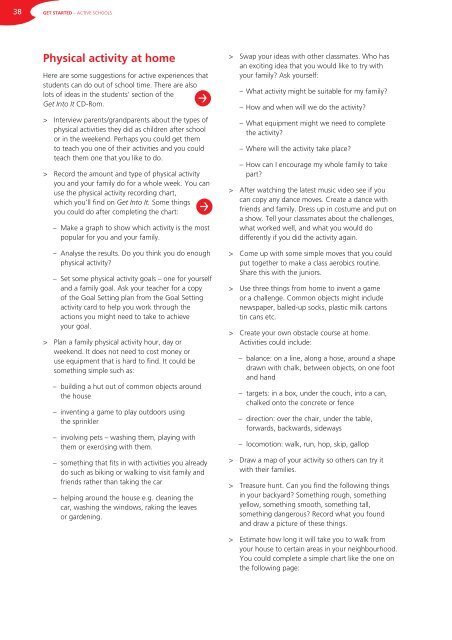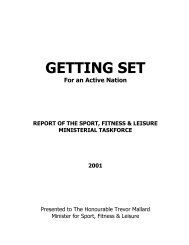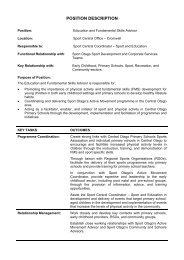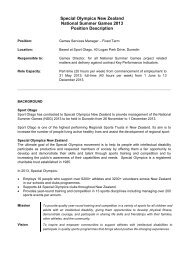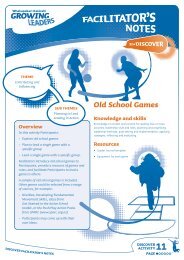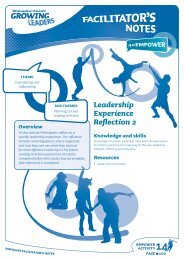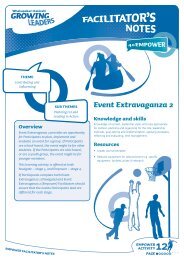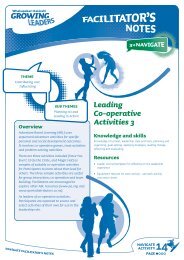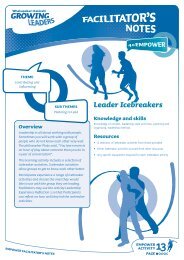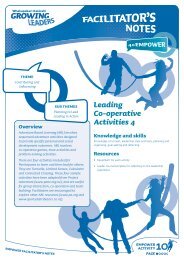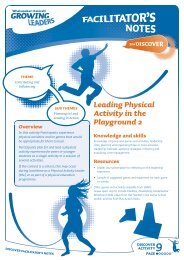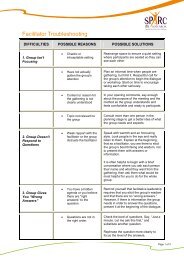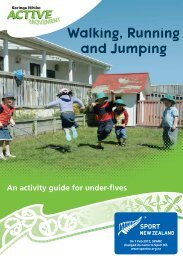Download Get Started (one document) - Sport New Zealand
Download Get Started (one document) - Sport New Zealand
Download Get Started (one document) - Sport New Zealand
Create successful ePaper yourself
Turn your PDF publications into a flip-book with our unique Google optimized e-Paper software.
38<br />
GET STARTED – ACTIVE SCHOOLS<br />
Physical activity at home<br />
Here are some suggestions for active experiences that<br />
students can do out of school time. There are also<br />
lots of ideas in the students’ section of the<br />
<strong>Get</strong> Into It CD-Rom.<br />
> Interview parents/grandparents about the types of<br />
physical activities they did as children after school<br />
or in the weekend. Perhaps you could get them<br />
to teach you <strong>one</strong> of their activities and you could<br />
teach them <strong>one</strong> that you like to do.<br />
> Record the amount and type of physical activity<br />
you and your family do for a whole week. You can<br />
use the physical activity recording chart,<br />
which you’ll find on <strong>Get</strong> Into It. Some things<br />
you could do after completing the chart:<br />
– Make a graph to show which activity is the most<br />
popular for you and your family.<br />
– Analyse the results. Do you think you do enough<br />
physical activity?<br />
– Set some physical activity goals – <strong>one</strong> for yourself<br />
and a family goal. Ask your teacher for a copy<br />
of the Goal Setting plan from the Goal Setting<br />
activity card to help you work through the<br />
actions you might need to take to achieve<br />
your goal.<br />
> Plan a family physical activity hour, day or<br />
weekend. It does not need to cost m<strong>one</strong>y or<br />
use equipment that is hard to find. It could be<br />
something simple such as:<br />
– building a hut out of common objects around<br />
the house<br />
– inventing a game to play outdoors using<br />
the sprinkler<br />
– involving pets – washing them, playing with<br />
them or exercising with them.<br />
– something that fits in with activities you already<br />
do such as biking or walking to visit family and<br />
friends rather than taking the car<br />
– helping around the house e.g. cleaning the<br />
car, washing the windows, raking the leaves<br />
or gardening.<br />
> Swap your ideas with other classmates. Who has<br />
an exciting idea that you would like to try with<br />
your family? Ask yourself:<br />
– What activity might be suitable for my family?<br />
– How and when will we do the activity?<br />
– What equipment might we need to complete<br />
the activity?<br />
– Where will the activity take place?<br />
– How can I encourage my whole family to take<br />
part?<br />
> After watching the latest music video see if you<br />
can copy any dance moves. Create a dance with<br />
friends and family. Dress up in costume and put on<br />
a show. Tell your classmates about the challenges,<br />
what worked well, and what you would do<br />
differently if you did the activity again.<br />
> Come up with some simple moves that you could<br />
put together to make a class aerobics routine.<br />
Share this with the juniors.<br />
> Use three things from home to invent a game<br />
or a challenge. Common objects might include<br />
newspaper, balled-up socks, plastic milk cartons<br />
tin cans etc.<br />
> Create your own obstacle course at home.<br />
Activities could include:<br />
– balance: on a line, along a hose, around a shape<br />
drawn with chalk, between objects, on <strong>one</strong> foot<br />
and hand<br />
– targets: in a box, under the couch, into a can,<br />
chalked onto the concrete or fence<br />
– direction: over the chair, under the table,<br />
forwards, backwards, sideways<br />
– locomotion: walk, run, hop, skip, gallop<br />
> Draw a map of your activity so others can try it<br />
with their families.<br />
> Treasure hunt. Can you find the following things<br />
in your backyard? Something rough, something<br />
yellow, something smooth, something tall,<br />
something dangerous? Record what you found<br />
and draw a picture of these things.<br />
> Estimate how long it will take you to walk from<br />
your house to certain areas in your neighbourhood.<br />
You could complete a simple chart like the <strong>one</strong> on<br />
the following page:


